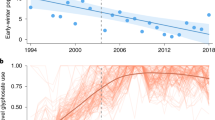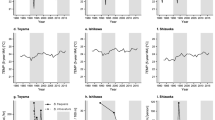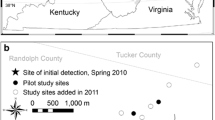Abstract
The population dynamics of the yellowjacket wasp (Vespula germanica Fabricus) in central Chile were analyzed for the first time. Using a simple Ricker logistic model and adding the effects of local weather variables (temperature and precipitation) and large-scale climate phenomena as El Niño Southern Oscillation (ENSO) and the Southern Annular Mode (SAM), we modeled the interannual fluctuations in nest density. The best model according to the Bayesian information criterion (BIC) included 1-year-lag negative feedback combined with the positive additive effects of ENSO and SAM. According to this model, yellowjacket nest density was favored by warm and dry winters, which probably influenced the survival of overwintering queens. Large-scale climatic variables [Southern Oscillation Index (SOI) and SAM] described the effect of exogenous factors in wasp fluctuations better than local weather variables did. Our results emphasize the usefulness of climate indices and simple theoretical-based models in insect ecological research.



Similar content being viewed by others
References
Aceituno P (1992) El Niño, the southern oscillation, and ENSO: confusing names for a complex ocean–atmosphere interaction. Bull Am Meteorol Soc 73:483–485
Akree R, Reed H (1981) Population cycles of yellowjackets (Hymenoptera: Vespinae) in the Pacific Northwest [Idaho; Oregon; Washington]. Environ Entomol 10:267–274
Andreoli R, Kayano M (2005) ENSO-related rainfall anomalies in South America and associated circulation features during warm and cold Pacific decadal oscillation regimes. Int J Climatol 25:2017–2030
Archer M (1985) Population dynamics of the social wasps Vespula vulgaris and Vespula germanica in England. J Anim Ecol 54:473–485
Archer M (1998) The world distribution of the Euro-Asian species of Paravespula (Hym, Vespine). Entomol Mon Mag 134:279–284
Archer M (2001) Changes in abundance of Vespula germanica and V. vulgaris in England. Ecol Entomol 26:1–7
Barlow N, Beggs J, Barron M (2002) Dynamics of common wasps in New Zealand beech forests: a model with density dependence and weather. J Anim Ecol 71:663–671
Barros V, Doyle M, Camilloni I (2008) Precipitation trends in southeastern South America: relationship with ENSO phases and with low-level circulation. Theor Appl Climatol 93:19–33
Beggs J (2001) The ecological consequences of social wasps (Vespula spp.) invading an ecosystem that has an abundant carbohydrate resource. Biol Conserv 99:17–28
Berryman A (1999) Principles of Population Dynamics and Their Applications. Stanley Thornes Publishers Ltd, Cheltenham
Berryman A, Turchin P (2001) Identifying the density-dependent structure underlying ecological time series. Oikos 92:265–270
Curkovic T, Araya J, Guerrero M (2004) Avances en el manejo de la avispa chaqueta amarilla en Chile. Aconex 84:19–24 (in Spanish)
Edwards R (1976) The world distribution pattern of the German wasp, Paravespula germanica (Hymenoptera: Vespidae). Entomol Ger 3:69–271
Elton C (1924) Periodic fluctuations in the numbers of animals: their causes and effects. J Exp Biol 2:119–163
Estay S, Lima M, Labra F (2009) Predicting insect pest status under climate change scenarios: combining experimental data and population dynamics modelling. J Appl Entomol 137:491–499
Garreaud R, Vuille M, Compagnucci R, Marengo J (2008) Present-day South American Climate. Palaeogeogr Palaeoclimatol Palaeoecol. doi:10.1016/j.palaeo.2007.10.032
Gillett N, Kell T, Jones P (2006) Regional climate impacts of the Southern Annular Mode. Geophys Res Lett 33:L23704
Harris R (1996) Frequency of overwintered Vespula germanica (Hymenoptera: Vespidae) colonies in scrubland-pasture habitat and their impact on prey. N Z J Zool 23:11–17
Harris R, Oliver E (1993) Prey diets and population densities of the wasps Vespula vulgaris and V. germanica in scrubland-pasture. N Z J Ecol 17:5–12
Holmgren M, Scheffer M, Ezcurra E, Gutiérrez J, Mohren G (2001) El Niño effects on the dynamics of terrestrial ecosystems. Trends Ecol Evol 16:89–94
Huey R, Berrigan D (2001) Temperature, demography, and ectotherm fitness. Am Nat 158:204–210
Jaksic F (2001) Ecological effects of El Niño in terrestrial ecosystems of western South America. Ecography 24:241–250
Kasper M (2004) The Population Ecology of an Invasive Social Insect, Vespula Germanica (Hymenoptera: Vespidae) in South Australia, Thesis, University of Adelaide, School of Earth and Environmental Sciences, Discipline of Environmental Biology, Adelaide
Kirchgässner G, Wolters J (2007) Introduction to modern time series analysis. Springer, Berlin
Lima M, Keymer J, Jaksic F (1999a) ENSO-driven rainfall variability and delayed density-dependence cause rodent outbreaks in western South America: from demography to population dynamics. Am Nat 153:476–491
Lima M, Marquet P, Jaksic F (1999b) El Niño events, precipitation patterns, and rodent outbreaks are statistically associated in semiarid Chile. Ecography 22:213–218
Lima M, Stenseth N, Jaksic F (2002) Food web structure and climate effects in the dynamics of small mammals and owls in semiarid Chile. Ecol Lett 5:273–284
Lowe S, Browne M, Boudjelas S, De Poorter M (2000) 100 of the world’s worst invasive alien species: a selection from the global invasive species database. Published by The Invasive Species Specialist Group (ISSG) a specialist group of the Species Survival Commission (SSC) of the World Conservation Union (IUCN), New Zealand
Madden J (1981) Factors influencing the abundance of the European wasp (Paravespula germanica F.). J Aust Entomol Soc 20:59–65
Marshall G (2003) Trends in the Southern Annular Mode from observations and reanalyses. J Climate 16:4134–4143
Matthews R, Goodisman M, Austin A, Bashford R (2000) The introduced English wasp Vespula vulgaris (L.) (Hymenoptera: Vespidae) newly recorded invading native forests in Tasmania. Aust J Entomol 39:177–179
Murúa R, Gonzalez L, Lima M (2003a) Population dynamics of rice rats (a Hantavirus reservoir) in southern Chile: feedback structure and non-linear effects of climatic oscillations. Oikos 102:137–145
Murúa R, González L, Lima M (2003b) Second-order feedback and climatic effects determine the dynamics of a small rodent population in a temperate forest of South America. Popul Ecol 45:19–24
R Development Core Team (2008) R: a language and environment for statistical computing. R Foundation for Statistical Computing, Vienna, Austria. http://www.R-project.org
Ricker W (1954) Stock and recruitment. J Fish Res Board Can 11:559–623
Royama T (1992) Analytical population dynamics. Chapman & Hall, London
Sackmann P, D’Adamo P, Rabinovich M, Corley J (2000) Arthropod prey foraged by the German wasp (Vespula germanica) in NW Patagonia, Argentina. N Z Entomol 23:55–59
Saldaña S, Lima M, Estay S (2007) Northern Atlantic Oscillation NAO effects on the temporal and spatial dynamics of green spruce aphid populations at UK. J Anim Ecol 76:782–789
Schwarz G (1978) Estimating the dimension of a model. Ann Stat 6:461–464
Sheiner L, Beal S (1981) Some suggestions for measuring predictive performance. J Pharmacokinet Phar 9:503–512
Silvestri G, Vera C (2003) Antarctic Oscillation signal on precipitation anomalies over southeastern South America. Geophys Res Lett 30:2115
Stenseth N, Ottersen G, Hurrell J, Mysterud A, Lima M, Chan K, Yoccoz N, Adlandsvik B (2003) Studying climate effects on ecology through the use of climate indices: the North Atlantic Oscillation, El Nino Southern Oscillation and beyond. Proc R Soc B 270:2087–2096
Acknowledgments
We thank the operators, forest rangers, and staff of the National Forestry Corporation, Metropolitan Region (CONAF RM) who collected the data for 12 years, especially to Mr. Luis Ulloa and Mr. José Barrera. S.E. acknowledges the financial support of the CONICYT Doctoral scholarship. S.E. and M.L. acknowledge financial support from FONDAP-FONDECYT grant 1501-0001 (Program 2).
Author information
Authors and Affiliations
Corresponding author
Rights and permissions
About this article
Cite this article
Estay, S.A., Lima, M. Combined effect of ENSO and SAM on the population dynamics of the invasive yellowjacket wasp in central Chile. Popul Ecol 52, 289–294 (2010). https://doi.org/10.1007/s10144-009-0179-8
Received:
Accepted:
Published:
Issue Date:
DOI: https://doi.org/10.1007/s10144-009-0179-8




